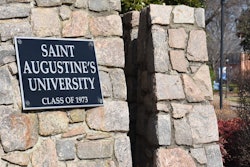Is It Just a Campaign Commitment
Despite Texas’ election-year settlement with the Office of Civil Rights, future HBCU funding levels remain
uncertain
AUSTIN, Texas — Funny what a political election can do for higher education. Some schools in key communities get greater state funding. Others get varied gifts that can come in the form of sizable grants, new athletic stadiums or assorted other forms.
But the long-overdue settlement of an almost 30-year desegregation case against this state has some observers wondering aloud if Gov. George W. Bush isn’t using the very serious discrepancies between Texas’ Black and White institutions to boost his presidential campaign.
Signed and sealed late last month, officials from Texas and the U.S. Department of Education’s Office of Civil Rights finally entered into a pact to resolve inadequacies in the state’s two historically Black colleges — Texas Southern and Prairie View A&M universities — and in the access that students of color have to the traditionally White institutions here.
“On one level, I’m shocked, but on another level, I’m not,” says Dr. M. Christopher Brown, professor of higher education at the University of Illinois, Urbana-Champaign, who published his research about college desegregation in the Southern and border states in the 1999 book, The Quest to Define Collegiate Desegregation. “I’m shocked that Texas would enter into an agreement, because they have been so hands-off on compliance issues for so long. But it is an election year.”
Known as the Texas Commitment, the accord “represents the latest initiative by the state to enhance and expand opportunities for minority participation and success in Texas’ higher education system,” reads a statement from Bush executive assistant Clay Johnson. “It provides an effective and thorough process that will enable the state to address the concerns raised by OCR regarding the state’s obligations. In particular, this agreement provides a blueprint for achieving academic excellence” at Texas Southern and Prairie View.
“I want all Texans to have an opportunity to enjoy the benefits of our state’s higher education system,” said a written statement from Bush, who spoke at Prairie View’s commencement last month. “Strengthening Prairie View and Texas Southern, along with our state’s other public universities, is important to making sure every Texan has access to a quality, affordable education.”
But after the dust settles in this Lone Star state, when all the photo ops and the election-year politicking subside, many observers wonder how much the agreement forces Texas officials to really improve the lot of Texas’ neediest students, its most resource-strapped colleges and the very future of the economy of the state.
“I don’t trust this document,” Brown says. “This is a very friendly document toward Texas. I’m just guardedly hoping that it’s not too friendly.”
The Covenant
Until last month, Texas, which has been operating under several state-approved desegregation plans, was one of the three states not in compliance with Title VI of the 1964 Civil Rights Act, which bans discrimination in federally subsidized schools. Virginia and Maryland are still in noncompliance, and while Texas has settled, federal officials are continuing to monitor efforts to eliminate dual systems of higher education.
The settlement calls for the Texas Higher Education Coordinating Board, a regulatory agency that oversees state-supported universities and community colleges, to develop a comprehensive plan for improving Texas Southern and Prairie View. The plan is supposed to include steps to achieve five broad goals, which are to:
n Further define and enhance the missions of Texas’ historically Black institutions and ensure that they don’t promote racial identifiability but instead foster desegregation.
n Strengthen existing academic programs at Prairie View and Texas Southern, and authorize new, “high value, high demand” programs there that are not “unnecessarily duplicative” of programs offered by nearby majority White colleges. (OCR officials have contended that Texas Southern does not academically distinguish itself from the University of Houston, nor Prairie View from Texas A&M University.)
n Provide Texas’ historically Black institutions with the facilities and other resources needed to support existing and new programs.
n Improve facilities and campus environments at Texas Southern and Prairie View so that they are equal to majority White counterparts in landscape, ambience and appearance, quality, adequacy and space availability.
n Improve the recruitment, retention and participation rates of African American and Hispanic students at the state’s majority White colleges.
“We have agreed to a process and it is my hope that the state of Texas will come together and live up to this agreement. We have reached resolution on this issue,” says Raymond Pierce, deputy assistant secretary for the civil rights office, who negotiated the Texas settlement. “These are old (legal) cases and a chapter in American history that needs to be resolved.”
But the settlement doesn’t mean Texas is out of the woods.
“This is designed to address our Title VI concerns,” Pierce says. “It’s a set of principles with a commitment from Gov. Bush. This does not mean Texas is in compliance yet. It’s designed to bring the state into compliance.”
What the Numbers Say
But Bush spokesman Mike Jones contends that some improvements already have occurred. He notes that during Bush’s tenure, total state funding to Prairie View and Texas Southern has increased, as well as the state’s funding per student at those schools.
For fiscal 1995, right after Bush’s first election, the state spent $6,900 per student at Prairie View and $7,314 at Texas Southern. Meanwhile, the state spent an average of $8,145 per student among the majority White universities that year. This fiscal year, the state is spending $12,378 per student at Prairie View and $13,503 at Texas Southern. Among majority White colleges, the state is spending an average of $11,130 per student.
For fiscal 1995, the state allocated a total of $21 million to Prairie View and $38 million to Texas Southern. This fiscal year, Prairie View is receiving $36 million and Texas Southern $43 million.
Jones also notes that Texas Southern’s increased funding coincides with the university’s enrollment dropping 40 percent, even though appropriations are based on enrollments.
During the 1990s, Education Department officials determined that Texas Southern staff was approving financial aid for any student who applied, regardless of eligibility. So until earlier this year, the Education Department required that the university provide financial aid up front, then file for reimbursement. University officials have cracked down on students and they contend that enrollment dropped because students no longer receiving federal financial aid simply didn’t enroll.
“Gov. Bush is obviously a strong advocate of these schools and strengthening them,” spokesman Jones says.
But a close examination reveals gaping discrepancies. Salaries for instructors at the historically Black colleges still lag behind their White counterparts. During the 1998-99 academic year, full-tenured professors earned $75,220 at Texas A&M and $78,961 at the University of Houston. Meanwhile, equivalent positions at Texas Southern paid only $55,667, and Prairie View paid $51,131.
University of Houston and Texas A&M also have many more facilities. Texas A&M has more than 16 million square feet and the University of Houston more than 6 million square feet when sizing up total area for classrooms, libraries, research and laboratory space and other instructional areas. Meanwhile, Prairie View has only 2.1 million square feet and Texas Southern only 1.6 million square feet.
No Admission of Guilt
Brown, of Illinois, believes the settlement between Texas and the Department of Education has loopholes. He criticizes wording in the six-page document that says Texas will cooperate “without admitting that any of its present day policies or practices are traceable to its prior de jure dual system.”
“But they are guilty, or there would not be a need for a settlement,” Brown says, adding that he wonders whether such wording will dilute the federal government’s oversight.
“Maybe the OCR wants to say at the end of the Clinton era that they have settled these cases and it gives everyone some sense of success,” he says. “But … filing suit might one day be in line, and I don’t know if this will give the OCR the teeth to do it.”
Brown also warns that the Texas Commitment has similar weaknesses to consent decrees in other states, where no plans are outlined for long-term maintenance and follow-up to the original commitment, and state appropriations often come up short.
After examining the Texas higher education system in the late 1970s, officials from the civil rights office determined that Blacks were segregated and Hispanics under-represented in student enrollment and in faculty at Texas’ public universities.
After submitting a provisional plan in 1981 and negotiating their terms, Texas officials submitted a final plan in 1983.
Education department officials accepted the document, known as the Texas Plan, to cover 1983 through 1988. Texas voluntarily developed and implemented a second plan, covering 1989 through 1994, and then followed with a third document.
But the federal government and Texas had not settled the original discrimination dispute before the U.S. Supreme Court in the 1990s ruled against Mississippi in the Fordice case. The high court ruled that race-neutral policies alone were not sufficient to determine that a state had effectively met its obligation to dismantle a formerly segregated higher education system.
The findings in Fordice led officials from the civil rights office last year to decide that Texas may be promoting segregation because White students did not have enough academic reasons to attend Prairie View or Texas Southern.
Let’s Make a Deal
So a deal was struck last year among the education department, Bush’s office and Texas’ coordinating board, which already had decided to develop a new higher education plan. Coordinating board officials appointed a special panel to address the desegregation issues, as well as committees examining other aspects of Texas higher education.
The process became visibly politicized this past March, when the Rev. Jesse Jackson traveled to Houston to lead a march of 700 from Texas Southern’s shabby promenade to the palm-lined sidewalks of the University of Houston.
There, he called for Bush to immediately convene a special legislative session to equalize funding between the historically Black colleges and their majority White counterparts. Meanwhile, Bush supporters accused Jackson and some Black Democrats of using the issue to try to derail the Bush campaign.
Regardless, the special panel recently issued recommendations to improve Texas Southern and Prairie View (see Black Issues, May 25). For Prairie View, the panel suggested, among other things, creating a “university college” to increase retention and graduation and developing new degreed programs in electrical engineering, construction science, interior design and juvenile forensic psychology.
For Texas Southern, the panel suggested things such as increasing enrollment, building more student housing, establishing an institutional development office to increase fund-raising and establishing summer and first-year support programs for incoming freshmen.
OCR officials are reviewing the Texas panel’s recommendations and expect to officially respond this month, Pierce says. The state Coordinating Board will vote on the recommendations in October. Their vote becomes a recommendation to Texas lawmakers, who convene in January for their biennial session and will decide on funding and what actually will be implemented.
State education leaders still are figuring the costs, but early estimates are that they could run $60 million for each university over a six-year state spending cycle.
In a statement issued by Bush, the governor says he is “committed to advocating the plan’s implementation and the allocation of necessary resources for the plan by the Texas Legislature.” If Bush is elected president, fellow Republican Rick Perry, the state’s lieutenant governor, would replace him.
Brown, of Illinois, says the special panel’s recommendations are similar to proposals adopted in Pennsylvania and Florida, which also have state regulatory boards overseeing the higher education systems there.
“And with the turnover on those boards, every couple of years, they come out and say they’re going to do what they are already doing,” Brown says.
‘Will this list do it?’
So why haven’t these things been done in Texas? It’s not clear.
Political support may come into play. On the one hand, Bush is the first Texas governor in 20 years to win a second consecutive term. On the other hand, former Prairie View president Gen. Julius Becton, whose tenure during the early 1990s stretched under governors from two political parties, says he always had support from lawmakers, no matter which party was in control. His predecessor, Dr. Percy Pierre, says he had similar support during his tenure.
And will such improvements encourage noticeable numbers of students to bypass elite schools such as the University of Texas to attend Prairie View or Texas Southern?
Becton doubts it. “Will this list do it? I don’t think so,” he says. “They could do it if they were able to create the environment to better compete.”
University of Houston Provost Dr. Edward Sheridan says the University of Texas will continue to draw away the cream of the academic crop. There’s no question it’s an elite institution,” he says. “The top students who want to stay in Texas are going to go there.”
Prairie View President Dr. Charles Hines says he remains confident that Bush and state lawmakers will honor their promises once the Legislature convenes for its biennial session in January. He says the state panel’s recommendations were based on a list of needs he had pitched himself.
“I had identified all of these needs before the 1999 Legislature,” Hines says. “This list is not new. I have articulated our needs in detail and participated vigorously in the OCR process. No one can say that I didn’t give input. I don’t know if the Legislature is going to fund any of it, of course, but obviously, if they gave me all the money in the world, I could spend it by 5 o’clock.
“All we want at Prairie View is to be relevant to the state of Texas,” he adds.
Texas Southern officials have been markedly quiet about the situation. University officials distanced themselves from Jackson’s March protest and the university’s president, Dr. Priscilla Slade, did not respond to repeated requests for a Black Issues interview.
But Sheridan, who also was a member of the special Texas panel, says improvements at the historically Black colleges are crucial to academic and economic growth in Houston and in Texas — respectively the nation’s fourth-largest city and a state where minorities rapidly are becoming the majority.
Unlike other ethnically diverse cities such as Chicago, Houston still lacks a Research I institution. Meanwhile, the state is seeing rapid growth among Hispanics — an alarming percentage of whom can’t read or write. According to the National Library of Education, the literacy rate among Hispanics in Houston was 31 percent in 1993.
“A lot of the concerns that are out there aren’t real,” Sheridan says. “There is all kinds of room for growth. Texas Southern simply isn’t duplicative of us. If Prairie View and Texas Southern got all of the things they asked for, they would do very well, and it would not hurt any of the other universities in the area.”
Of all the applicants that apply to Texas Southern and University of Houston law schools, for instance, only 1 percent of all applicants applies to both, he says. And among all academic programs, only 16 percent of Houston’s offerings also are offered at Texas Southern, he says.
Sheridan, who is White, says University of Houston officials are not interested in absorbing Texas Southern and its students.
“Some of that fear exists, but both schools are as busy as we can be,” he says. “We want to do more collaboratively in research, in joint programs. Our university will be better if Texas Southern gets better.”
© Copyright 2005 by DiverseEducation.com















